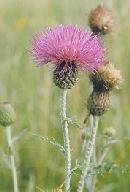
@Kurt Aldolfson

@Kurt Aldolfson
Wavy Leaf Thistle
Cirsium undulatum (Nutt). Spreng.
A stout perennial from a that taproot, which sometimes branches below ground. It has rose-purple flower heads that may be over two inches wide and an inch and a half tall. The heads contrast with the whitish gray leaves that are covered with wooly hairs. There are sharp yellow spines that project from the intricately cut leaves and the sides of the flower heads. Flowers in June through September. At maturity, the airborne seeds with their feathery bristles are termed thistledown. Grows on hillsides, prairies, railroad-tracks, and other open places, in well drained soil;
Food Use:
The thick roots of wavy leaf thistle were cooked for food by several
tribes of native Americans. Root may be eaten raw or cooked. One of the more palatable
thistles, it is used as a vegetable or can be added to soups and stews. It can
be dried and stored for winter use. The root is likely to be rich in, a starch
that cannot be digested by humans. This starch thus passes straight through the
digestive system and, in some people, ferments to produce flatulence. Stems may
also be peeled and eaten raw or cooked. One of the more palatable thistles.
Medicine:
A decoction of the root has been used in the treatment of
gonorrhoea. A cold infusion of the root has been used as a wash for eye
diseases.